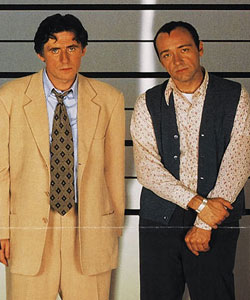 Initial Business
Initial Business
Okay, first — if you haven’t seen The Usual Suspects yet:
1) Punch yourself in the gut, because you deserve it.
2) Stop reading this article now — thar be spoilers… and this is one movie you do not want to spoil. [insert diabolical laughter here]
All right, now that that’s out of the way… I had the craziest conversation at my weekly screenwriters’ group meeting last night. One of our members was plotting a new thriller and was using The Usual Suspects as one of her story models. Possibly a risky move, but so far so good.
She was talking about how her main character is like Dean Keaton (played by Gabriel Byrne). That’s fine, but then she offhandedly referred to Dean Keaton as the protagonist of The Usual Suspects.
And then things really got weird.
Another member of the group agreed with her! And she has her Master’s Degree in Screenwriting from USC!
After my brain stopped exploding, I started going over the movie, and the criteria for a protagonist, in my head. I needed to remember why I believed it was all about Verbal Kint (Kevin Spacey).
Verbal Kint — Protagonist?
Let’s look at the evidence for Verbal Kint as the protagonist of the movie:
– He’s the one telling us the story of what happened — so it’s his story, and we’re seeing it from his point of view (or the point of view that he wants us to see it from).
– He’s the central character. Verbal is the only character present in both timelines (the past chain of events starting with the line-up, and the current interrogation by Agent Kujan (Chazz Palminteri) — and connects the two together.
– He changes the most. In the flashback tale, he goes from being a petty criminal to being an equal member of the gang of hardened crooks. In the interrogation story, he goes from being a wimpy guy trying to act tough, to a broken man who knows he’s just betrayed Keyser Soze, to… well, Keyser Soze, super villain.
– He’s the one we’re rooting for. We learn at the beginning of the movie that Verbal (“a cripple”) is the only character from the group who survived, therefore we sympathize with him and are really rooting for him to make it out of this whole experience. If the other usual suspects had simply escaped, then a good case could be made for having a stronger rooting interest for Dean Keaton — the reformed baddie who’s found love.
– He’s the one driving the plot forward. Verbal’s the one who convinces Dean Keaton to be part of the group. He’s the one who saves the day in the parking garage by killing the man in the car. And ultimately, he’s the one spinning the lies of the tale — which is tantamount to creating the plot itself.
Conclusion
Maybe brilliant writing is to blame for my group members’ belief that Dean Keaton is the protagonist. After all, there were enough key moments to make Agent Kujan believe that Dean Keaton was in fact the mastermind behind it all.
So Keyser Soze not only worked his magic on Agent Kujan, but also on my writing group buddies! However, in my opinion, Verbal Kint is the true protagonist.
In the end though, it only matters from an academic point of view who the protagonist is. The movie still kicks butt regardless.
But it’s always a worthwhile exercise to determine the protagonists (and antagonists) in movies so we can form a better understanding of what works, what doesn’t work and why. We can then apply that wisdom to our own scripts.
What’s your take? Who’s the protagonist of The Usual Suspects? Verbal Kint or Dean Keaton or both?





Okay, maybe I’m biased (I graduated from the screenwriting program at UCLA) but what I wanna know is “What are they teaching over there at USC?” Hands down – Verbal is the protagonist.
Looks like I’m firmly in the UCLA camp on this one. Thanks for the feedback!
Maybe you’re all wrong!
Have you seen the sequel screenplay – leaked from CAA -l posted on Pirate Bay, called Bear Trap – it’s a big ride – very original – a big budget, high concept blockbuster – and it rocks!
Nobodies been able to do it! – till now! A stunning multi-twist ending that blows the original away – All the questions – Verbal, Keaton, Kobayashi – Nah! Just read the sequel – it will turn your head inside out!
Remember, there are only 2 survivors of the whole incident, Verbal and a burnt to a crisp kidnapper. While Mr. Toasty describes Verbal, that doesn’t mean that he was really Keyser. Hell, the kidnapper could have been Keyser pulling the same s**t that Verbal was pulling in the office. Technically he has better motive to be a liar became it’s not like he is going to be able to run away.
The whole movie is a lie in which Verbal is the protagonist for no other reason as he is the one telling the story. Even bad guys think they are the heros in their own stories, so why would Mr. Kent be so different.
Hey MG, I like your Mr. Toasty theory. I hadn’t heard that one before. Good call.
And yeah, totally agree with you about the protagonist. The telling of the story is usually a dead giveaway… especially if the storyteller isn’t just bookending the story (i.e. Voiceover at the beginning and the end of the movie).
Actually spot on!
The sequel (The Usual Suspects 2- Bear Trap Revision 10.3) shows us that all is not what it seemed in the original, and indeed Verbal is not actually Keyser Soze – who the real Keyser Soze is? – is stunning!
Hey Blink/Segal. I’d love to take a look at your Usual Suspects script, but only if I can review the first five to ten pages on my site. I think it will be very educational for you (and my readers) to see what goes through the minds of professional script readers on a page by page basis.
Let me know.
No problem – just email me direct and I will send you a pdf copy
Regards
Blink
p.s. Try to do 15 -20 ( you may even do more – most people say it’s a good, easy read, compared to most screenplays) It got me a six figure, three installment writing job!
regards
Blink
No, your MA Screenwriter friend is right.
Admittedly, structure wise, it is confusing and people can be forgiven for believing that Verbal is the protagonist. Remember, he is the unreliable narrator. Here is my supporting evidence:
Verbal has no inciting incident. He has no call to action and he does not refuse the call. The is no turning point where he is dragged into the action. Verbal does not have a mid point crisis. He has no dramatic climax. All these things belong to Dean.
Verbal may be the central character but he is not the protagonist/hero. The unseen Keyser is the antagonist, thus Verbal. He has no real story of his own, he just tells everyone else’s story. You may say that verbal is the one that changes the most but he does not. He starts off as a fake, lying, fantasist and in the end he is a fake, lying, fantasist.
And if you look real close, he does not drive the plot. If you took his character out completely, the plot would still continue with Dean leading the action. dean is the one we are really rooting for, especially after Keysers threat via Kobayashi to kill Edie. We don’t need to root for Verbal because we know he escaped from the ship. If we knew the secret, we’d be rooting for the detective to unmask him.
This is a tragedy where the flawed hero, Dean, fulfils duty/destiny/task but dies because of it.
A close study of the Hero’s Journey and Syd Fields three-act-structure compared with the plot of The Usual Suspects will confirm this.
Watch my blog for news of a published in-depth analysis, which I intend to publish within the next few weeks.
http://www.johnmcwriter.wordpress.com
http://www.johnmc.co.uk
http://www.twitter.com/JohnMc_Lpool
Hey John Mc,
You make some excellent points. If my MA screenwriting friend had articulated her argument in that manner, she would have been far more convincing.
Give me some time to consider what you’ve said, and I’ll get back to you with my thoughts.
Thanks!
I completely agree with John Mc, because this is the concept that defies all the layman about who films are about. The hero’s Journey is the key. Instead of Protagonist, lets look at stories from Main character vs central character. If you go back to Homer’s illiad, Homer, the writer put himself in the story to tell it. The hidden writer telling fantastical tales of adventure from inside the camp. Zack Snyder, emphasised this moment in 300 when one of the 300 soldiers was sent home to tell the tale up until the last night.
Anyway, Main character is a person who usually has a dramatic arc of change as they go on a story of adventure which is the film. They usually experience the obstacles alongside the central character. the person who does all the action and conflict but in essence because they are a hero, they are usually unchanged.
Bruce Willis films are the best example of this theory, especially Die Hard. He enters the story sluggish but heroic. Going to be with his wife for the xmas. He’s a heroic cop who’s tired and flawed with personal issue. But when the inciting incident occurs, he moves in to action, saves the die and saves his wife. At the end he is merely bloody but still a hero. He proves it by making four more films. His character although a protagonist is considered a Central character. The person the story revolves around. And also who is important to the title of the film. One of the dead giveaways.
But who has the arc of change? The main character whom is usually the role for the hidden writer because as the author of this adventure, the writer tells the story of his paramour hero. His idol. So the person whop changes the most thru the arc of change is often the sidekick.
Look at sidekicks in films. The person who began the day like any other day until something happens. Rae Dawn chong in commando is a great example of this. She begins as a strong will stewardess preyed upon by David kelly. Schwarzenegger sees this and ellicits her help. At first she is reluctant, and then she goes along with shooting a bazooka at a police transport vehicle to free Arny. She has flying skills to fly him to the country. She is there at the end to take him and his daughter away. Not your usual girl in peril role. Centrally the film is about a commando who stops at nothing to free his daughter but viewed by our main character of the stewardess who is not just the girl but important to telling the story of this adventure.
Now back to Usual suspects. i agree with john Mc’s analysis on this basis. Verbal was never picked up in the roundup of the usual suspects. He is plopped in to the lineup like magic. Its more amazing that Palminterri doesn;t pick up on this. maybe he thinks, i’ll let this guy keep talking. But in main character style, Verbal does these different actions that john spoke of but they are all in reference to the main character of Keaton.
My interesting tidbit since the story is full of lies would be Verbal and keaton’s way of disguising Keaton by making up the character of Edie and Keaton is really… Koboyashi. (Probably spelled wrong) So how cool would it have been that when verbal reveals he could walk in the last sequence that it wa keaton behind the wheel as opposed to Postlewaithe?
Now that’s a thought?
Chase Johnston-Lynch — Now there’s a thought and a half! John Mc may be indeed be right, but I need some time to properly assess what he’s saying. Unfortunately time is not my ally this week as I’m shooting a short film in a few days.
But am I mistaken, or did you just try to argue that Rae Dawn Chong was the main character in COMMANDO??? If so, I think you just fell on your sword. 🙂
I know its hard to believe because you may be looking at my theory on the basis of a cheesy 80s action film and not from a writer’s standpoint on storytelling that travels way back to Homer’s epic poetry. The theory I am addressing in storytelling is that the writer, creates a hidden character to display the prowess of the Hero. I never said Rae dawn chong or any other female/sidekick is the hero. I said, that in theorum, the main character goes thru an arc of change dramatically. No hero, in any movie actually changes along this scale. They dont transform 3 dimensionally. They merely wake up or begin the film as a hero. Obviously they are hoisted foilbles and flaws on theior character. But they are Central characters to the story. Theyt save the day but dont change 3 dimensionally. they begin as a hero and return in sequesls as heroes again. Die Hard 1, 2, 3 and 5 show this theory in action. The sidekick, who follows them. So in essence shows their story the way a writer would when he tells it, they are the characters who changed dramatically.
So back to rae dawn chong. She begins as a tight dressed , straight laced, no nonsense stewardess that the hero sees something in. As well as the antagonist, Sully. SHe is takng out of her routine, dramatically and carried off in to the slipstream of this adventure and changes by the end of it. we learn various things along the way such as that she can also fly planes. She helps the hero find the island. what would the central character have done without hurt. Would he have saved the day. Arny even gets busted by the cops and is going to prison and Rae shpws up, blows up the poice van and rescues him.. how is she NOT the man character?
Your end of the lesson
Chase
Gentlemen and Ladies,
I totally can see all your points to Dean Keaton being the protagonist but you have to remember this one simple detail that can put all these things to rest.
The movie Ending in a sense begins with David Kujan’s look at the back wall. We see ON THE LOWER CORNER A SIGN SAYS “QUARTET-SKOKIE, IL
Verbal- “I WAS IN A BARBERSHOP QUARTET ONCE BACK IN SKOKIE, IL.
*We see A LIST OF NAMES ON THE BACK WALL- ONE OF THEM NAMED REDFOOT
Verbal-“REDFOOT WAS HIS NAME”
*A PICTURE OF A FAT WOMAN-
Verbal: “A BIG FAT GUY, ORCA FAT!”
*PIECE OF PAPER THAT SAYS A WINNING COMBINATION GUATEMALA
Verbal- “BACK IN WHEN I WAS IN GUATEMALA WE MADE THE BEST COFFEE”
*KOBAYASHI- THE NAME ON THE BOTTOM OF THE COFFEE MUG.
Verbal: “A lawyer.”
Cujan: “What’s was his name?”
Verbal: “KOBAYASHI”
So, analyzing all that, and allow a moment for it to sink in…
EVERYTHING THAT VERBAL HAS GIVEN US HAS BEEN FABRICATED TO A CERTAIN EXTENT!
Granted the their is no doubt that the main players/characters are all real-McManus,Fenster,Hackney,Keaton,Edie, Verbal, Cujan, the Argentinian Goons and Boss, and even Keyser Soze’s right hand man-WHOS NAME IS NOT KOBAYASHI!!!!!
But just because characters are real does not mean their stories are. Yes, to a certain extent, you have to believe that Hackney was the one who robbed the guns- affirmed by Keyser Soze’s no name henchman (b/c we have clairfied his name is NOT KOBAYASHI) around 55 minutes in. Keaton was a corrupt cop that now has turned good (until he decides to do the “new York’s finest taxi service job” and then the “coke job” and then the “Boat Job”) but also keep in mind- if we weren’t watching the action of the film, what would we be doing-well listening the Verbal Kint tell the story.
And that’s what this is-a story. A bunch of small truths rooted in the characters but the story as a whole is a lie. Or rather the way Verbal describing how all the actions that went down is a lie.
Cujan: asks him why he didn’t tell any of this to the D.A
Verbal: says he is afraid of keyser soze.
But truly it is b/c Verbal is telling a story. Something not totally true, for if it was he would have told the D.A. right? (And note that last sentence can be argued, because the movie sets up for us in a logical fashion that Kevin Spacey is Verbal Kint and Verbal Kint is Keyser Soze.
It is so interesting to watch this movie over and over and reach the conclusion that truly Verbal Kint is the made up persona/identity. As a post up above mentioned earlier he is just thrown into the lineup, they don’t show him getting arrested. What was he doing there? Well according to Keyser’s right hand man (still nameless) the lineup was a setup, arranged by Keyser Soze. So if we accept that Verbal is Kaiser (which at least I do b/c the movie sets it up logically that way from just what we are given in the dialogue) then we can attach that Verbal is in the lineup b/c he wants to be there. Keep in mind this Verbal Kint as the cop in the beginning tells Kujan that Verbal-“is protected from the high prince of darkness…this whole thing has gotten political, last night the mayor was here…etc) so if this verbal could be protected from say the mayor and other political figures isn’t it safe to assume (and honestly I hate saying that would “assume”) that Verbal can get fake identities, passports, licenses, etc. And so it becomes the idea that Verbal Kint is the real fake identity.
Keep in mind also Verbal’s/Keyser’s Key Line: “The greatest trick the devil ever pulled, was convincing the world he DIDN’T Exist.” the key word being “didn’t”- b/c by the end of the movie we have to stop accepting Verbal’s story for he has done that to Agent Cujan, he has convinced him that Keyser Soze is not a real man, but just KEATON who made up the myth, was using it to…WHAT?
Seriously if you want to argue for Dean Keaton as the protagonist, why does he do this job? Oh- b/c in your minds he is Keyser, and very well, good point but then I ask why is is downstairs saying “THERE’S NO COKE. THERE’S NO FUCKING COKE ON THIS SHIP” right as/before the Argentinian gets murdered by Keyser. How can Dean Keaton be in two places at once? BELOW THE DECK AND ON TOP OF IT!
And the easy defense is- you said sir the story is a lie. And ok, that’s right the story as a it is told wholly is a lie. So that refutes the points of Dean being two places at once, but I go back once again to who is telling the story-KEATON?
NO! It is Verbal/Keyser. Why would he lie about keaton being in one location and no the other. Yes Verbal “cared” about Keaton, but truthfully if you accept the clear fact that much of Verbal’s story has been made up or at least details of the story has been fabricated(see the opening of this argument for that evidence) doesn’t that call to mind the idea that he can/has lied before?
You see Verbal uses all of them (the usual suspects) to achieve his Goal- which we don’t realize until the last 15-20 minutes of the film is to kill that Argentinian, that is why there is no coke on the motherfucking boat!
*Verbal convinces Keaton to sign on the first job- “new York’s finest”
*Verbal sets the plan- for “new york’s finest job” -IF HE COULD PLAN THAT, WHAT ELSE CAN THIS MAN DO?
*Verbal shoots that man in the 1st coke job given to them by REDFOOT. Just cold as mr.dean keaton hesitates (b/c we can see keaton doesn’t want to kill anyone or else why would he hesitates?) Verbal shoots him cold and notice, no words are exchanged after between dean and verbal. Verb doesn’t said- I had to, or there was no choice, just shoots him cold so we see that Verbal can act and act with no emotion just pure “evil” i would say (and maybe that is an overstatement) but there is no logical reason that the dude in the car needs to die. OTHER than the fact that the deaths become something Keyser’s henchmen/Redfoot-who we know by the end is a made-up name/probably character(but i cannot prove it although I will make the claim that one of the members shot at the boat deal- i cannot remember/recall the specific time in the movie but I think it is when the shooting begins, the character that plays REDFOOT (that actor is there on the dock and shot in the back!!!!) WTF was he doing there? I don’t know and like I said I could be wrong on that, but i think it also could be an astute observation or they just needed another extra and they thought oh why dont we have one of the more minor characters we already cast do it- SO WE WONT NEED TO PAY TWO ACTORS)
Back to the “devil line” Also what is the point of that line. You have to remember that movies and books are different but well-written ones always have/use words to their advantage. That is to say there is always a clear,distinct reason behind a phrase being uttered. The phrase “The greatest trick the devil ever pulled was convincing the world he didnt exist.” What is the point of that line if the DEVIL who we parallel to Keyser in the way people describe the “mythical man”, DOES NOT EXIST. The line makes no sense! It doesn’t, so what’s the point? It would be like arguing that Kurtz’s “the horror, the horror” in Joseph Conrad’s Heart of Darkness doesn’t make sense or add any meaning to our interpretation of Kurtz’s character and what we think of him after he dies.
In closing, I could ramble on more, but I think I for the moment have made my point through enough.
The only logical argument I can make then for Mr.Dean Keaton being the protagonist is in Verbal’s story. That is to say you have to then accept that the movie-THE USUAL SUSPECTS- is a story within a story. And I am not going to go into an argument here, because that is a completely different argument than the one we are discussing.
But Verbal’s story he tells Agent Cujan: I can see Dean Keaton being the protagonist in that.
But the movie “THE USUAL SUSPECTS” is ultimately about Verbal/Keyser- his goal, his manipulation, and his escape out of being caught.
that being said, if anyone would like to refute a point feel free to post on here or email me directly at etm89973@creighton.edu And yes, I will state now that I am a student, and I see here we have people with M.A.’s arguing things and I will say that you all have more knowledge and experience with this than me from your works over the years. I am just looking at it from an academic standpoint- Of I justify my points with specific examples from the movie/text. For that is the only logical thing I can do to come to my conclusions and have strong faith that they are right.
That being said, I will leave you with the idea that movies/and film are meant to be interpreted and can have many interpretations, none of which can 100% be proven right or wrong. I am not a proponent of that belief, unless their is strong justification, but if you don’t agree with me, you do not have to, because the value/interpretation is in the eye of the beholder, so to speak.
And with that I am done…. for now.
Hey Eddie,
Some great points there and a thorough exegesis on the subject. I have to say, I agree with you. THE USUAL SUSPECTS is really a story within a story. For the movie, Verbal is the protagonist. For the story he tells, a case can be made for Dean Keaton being the protagonist. But we’re talking about the movie here, so Verbal gets the nod… in my opinion.